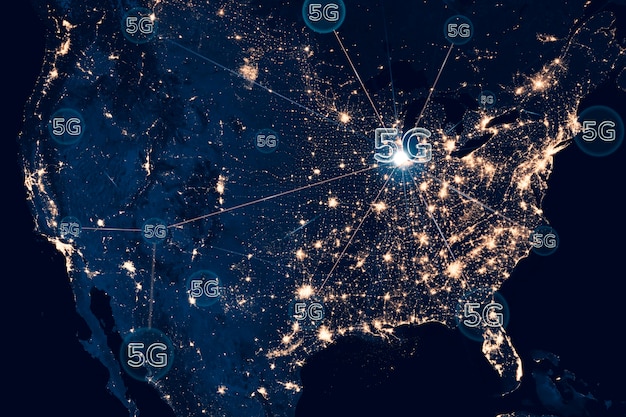Satellite Internet: The Future of US Telecommunications

Satellite internet is revolutionizing US Telecommunications by providing high-speed connectivity to underserved areas, enhancing communication infrastructure, and opening doors for emerging technologies, ensuring a more connected and advanced future for the nation.
In the realm of US Telecommunications, the future is rapidly unfolding, and satellite internet is poised to play a pivotal role. Offering connectivity solutions where traditional infrastructure falls short, satellite technology is set to redefine how Americans communicate and access information.
Satellite Internet: Bridging the Digital Divide in the US
The digital divide remains a persistent challenge in the US, with many rural and remote areas lacking access to reliable high-speed internet. Satellite internet offers a compelling solution, promising to connect underserved communities and unlock new opportunities for economic growth and social inclusion.
The Promise of Universal Connectivity
Satellite internet is not constrained by terrestrial infrastructure, making it an ideal solution for areas where fiber optic cables and cell towers are not economically feasible. This technology can provide consistent, high-speed internet access to homes, schools, and businesses in even the most remote locations.
Economic and Social Impact
Bridging the digital divide with satellite internet can have a profound impact on the US economy and society. Access to reliable internet can enable remote work, online education, telemedicine, and e-commerce, empowering individuals and communities to participate fully in the digital age.
- Enhanced Education: Students in rural areas can access online learning resources and participate in virtual classrooms.
- Improved Healthcare: Telemedicine services can connect patients in remote areas with specialists and healthcare providers.
- Economic Growth: Businesses in underserved areas can leverage internet connectivity to expand their market reach and improve operational efficiency.
- Community Development: Access to information and communication tools can foster civic engagement and community development.

Satellite internet is more than just a technological solution; it is a key enabler of social and economic progress, ensuring that all Americans have the opportunity to thrive in the digital world. By overcoming the limitations of traditional infrastructure, satellite internet is paving the way for a more connected and equitable future for the US.
Technological Advancements Driving Satellite Internet Growth
Recent advancements in satellite technology are significantly enhancing the performance and affordability of satellite internet services. These innovations are making satellite internet a more competitive and viable option for US consumers and businesses.
Low Earth Orbit (LEO) Satellites
LEO satellites orbit closer to the Earth than traditional geostationary satellites, resulting in lower latency and faster speeds. Companies like SpaceX’s Starlink and Amazon’s Kuiper are deploying massive constellations of LEO satellites, promising to deliver fiber-like internet performance to users across the US.
Improved Satellite Design and Efficiency
New satellite designs and technologies are increasing bandwidth capacity and reducing the cost per bit of data transmitted. These innovations are making satellite internet more affordable and accessible to a wider range of users.
Innovations in satellite technology are rapidly transforming the landscape of satellite internet, making it a more attractive and practical option for consumers and businesses:
- Increased Bandwidth: Advanced modulation techniques and higher frequency bands are enabling faster data transfer rates.
- Reduced Latency: LEO constellations and improved signal processing are minimizing delays in data transmission.
- Lower Costs: Economies of scale and technological advancements are driving down the cost of satellite internet equipment and services.
The technological advancements are significantly improving the capabilities and competitiveness of satellite internet, positioning it as a key player in the future of US telecommunications. As these technologies continue to evolve, satellite internet will become an even more attractive alternative to traditional internet options.
The Competitive Landscape of Satellite Internet Providers in the US
The satellite internet market in the US is becoming increasingly competitive, with several major players vying for market share. Consumers and businesses now have a growing range of options to choose from, each with its own strengths and weaknesses.
Key Players in the US Market
Companies like Viasat, HughesNet, SpaceX (Starlink), and Amazon (Kuiper) are leading the charge in the US satellite internet market. Each company offers different service plans, coverage areas, and equipment options, catering to a diverse range of customer needs.
Service Offerings and Pricing
Satellite internet providers offer a variety of service plans with different data allowances, speeds, and pricing. Consumers should carefully evaluate their internet needs and compare the available options to find the best fit for their budget and usage patterns.

Understanding the competitive landscape is crucial for consumers seeking satellite internet services. Here are some factors to consider when evaluating different providers:
- Coverage Area: Ensure that the provider offers service in your specific location.
- Data Caps: Be aware of any data limits and overage charges.
- Equipment Costs: Consider the upfront costs of satellite dishes and other equipment.
- Customer Support: Research the provider’s reputation for customer service and technical support.
The competitive landscape of satellite internet providers in the US is dynamic and evolving. As new players enter the market and existing providers expand their offerings, consumers will have even more choices and opportunities to benefit from this transformative technology.
Satellite Internet and the Future of Rural Business in America
For rural businesses across America, reliable internet access is no longer a luxury but a necessity for staying competitive in today’s digital economy. Satellite internet is emerging as a pivotal enabler, providing the connectivity needed to thrive in remote and underserved areas.
Enabling E-commerce and Remote Operations
Satellite internet unlocks new opportunities for rural businesses to engage in e-commerce, expand their market reach, and streamline remote operations. This connectivity allows businesses to connect with customers globally and adapt to the evolving demands of the modern marketplace.
Supporting Precision Agriculture and Smart Farming
In the agricultural sector, satellite internet is playing a crucial role in supporting precision agriculture and smart farming practices. Farmers can use connected sensors, drones, and data analytics tools to optimize crop yields, manage resources efficiently, and improve overall productivity.
Satellite internet offers various benefits for rural businesses:
- Expanded Market Reach: Rural businesses can tap into global markets through e-commerce platforms.
- Improved Efficiency: Businesses can take advantage of cloud-based applications to streamline operations and enhance productivity.
- Enhanced Customer Service: Rural businesses can provide better customer service through online support channels.
Satellite internet is essential for the economic vitality of rural communities, empowering businesses to innovate, grow, and contribute to the overall prosperity of the nation. By providing reliable connectivity where traditional infrastructure is lacking, satellite internet is leveling the playing field and creating new opportunities for rural businesses to compete and succeed.
Challenges and Limitations of Satellite Internet
While satellite internet offers numerous benefits, it is also essential to acknowledge its challenges and limitations. Understanding these constraints is crucial for setting realistic expectations and making informed decisions about its adoption.
Latency Issues
Even with LEO satellites, latency can still be a factor, especially for real-time applications like online gaming and video conferencing. While latency has improved significantly, it may still be noticeable compared to terrestrial internet connections.
Weather Sensitivity
Satellite internet can be affected by adverse weather conditions, such as heavy rain and snow, which can disrupt the signal and reduce performance. This vulnerability can be a concern in certain regions of the US.
Data Caps and Pricing
Satellite internet plans often come with data caps, which can limit usage for bandwidth-intensive applications. Pricing can also be higher compared to terrestrial internet options, especially for plans with larger data allowances.
Understanding is important:
- Latency Considerations: Latency can impact real-time applications.
- Weather-Related Disruptions: Adverse weather can affect signal quality.
- Data Usage Limits: Awareness of data caps helps avoid unnecessary charges.
Acknowledging the inherent limitations is imperative for a fair assessment of its viability. By addressing these challenges and exploring potential solutions, the effectiveness and reliability of satellite internet can be further enhanced, making it a more compelling option for users across the US.
Future Trends and Innovations in Satellite Internet
The landscape of US telecommunications is poised for significant transformation as satellite internet continues to evolve. Several key trends and innovations are shaping the future of this technology, promising to enhance its performance, accessibility, and overall impact.
Integration with 5G and other Networks
Satellite internet is increasingly being integrated with 5G and other terrestrial networks to create seamless hybrid solutions. This integration can extend the reach and reliability of 5G services, particularly in rural and remote areas.
Advancements in Satellite Technology
Ongoing advancements in satellite technology, such as laser communication and mesh networking, are further enhancing the speed, capacity, and efficiency of satellite internet. These innovations will enable even faster data transfer rates and more reliable connectivity.
Let’s explore the future of satellite internet in more detail:
- 5G Integration: Convergence of satellite and terrestrial networks for enhanced connectivity.
- Laser Communication: Higher bandwidth and faster data transfer rates.
- Mesh Networking: Improved network resilience and redundancy.
With an innovative mindset, US Telecommunications can continue. The impact of satellite internet will extend beyond basic connectivity, revolutionizing various industries and transforming the way people live and work. By embracing these emerging trends, the US can unlock the full potential of satellite internet and create a more connected and prosperous future for all.
FAQ
▼
Satellite internet provides internet access via satellites orbiting Earth. A satellite dish on the ground transmits and receives data from a satellite, which then communicates with an internet service provider.
▼
Advantages include availability in remote areas where traditional internet is not accessible, bridging the digital divide, supporting e-commerce, and enabling precision agriculture in rural areas.
▼
Disadvantages include higher latency compared to terrestrial internet, susceptibility to weather-related disruptions, and data caps that may limit usage for bandwidth-intensive applications.
▼
Key players in the US satellite internet market include Viasat, HughesNet, SpaceX (Starlink), and Amazon (Kuiper), each offering different service plans and coverage areas to cater to various customer needs.
▼
Satellite internet is transforming rural business by enabling e-commerce, remote operations, supporting precision agriculture, improving access to online resources, and enhancing customer service capabilities.
Conclusion
As US Telecommunications evolve, satellite internet emerges as a pivotal technology. Bridging the digital divide, enabling rural businesses, and driving innovation, this technology offers connectivity solutions that are essential for a more connected and prosperous future. While challenges remain, ongoing advancements promise to enhance satellite internet’s performance and accessibility, solidifying its role in the US telecommunications landscape.





